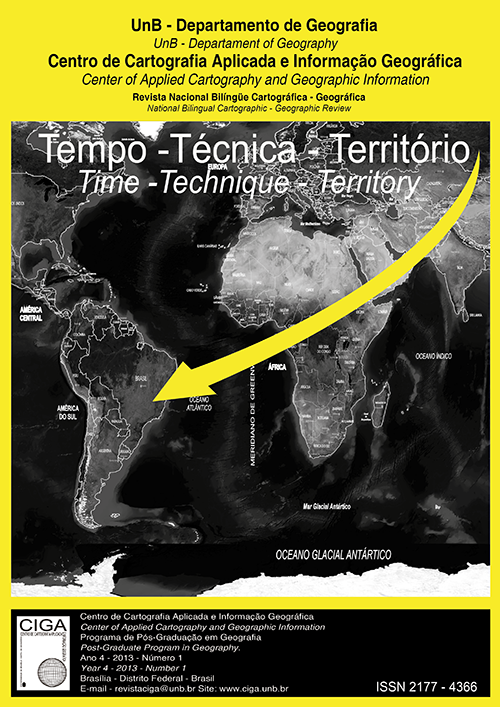USING DIRECTIONAL AND HYPERSPECTRAL REMOTE SENSING OBSERVATIONS FOR IMPROVING CROP CLASSIFICATION
DOI:
https://doi.org/10.26512/ciga.v4i1.16321Resumo
Mapping accurately agricultural fields is one of the main challenges for monitoring areas using remote sensing. Crops change during the growing season and it is often desirable to use images acquired at several dates for plant identification. However, there is a high cost for these image acquisitions. Airborne or satellite campaigns usually cover specific regions for specific dates then offering limited data. Advances in sensor technologies created hyperspectral sensors to overcome this spectral limitation of multispectral sensors.Downloads
Referências
ASNER, G. Braswell et al. Ecological research need from multiple remote sensing data. Remote Sensing of Environment (63), 1998 p.155-156.
BEISL, U. Correction of Bidirectional effects in imaging Spectrometer Data, Remote Sensing Series, 37, 2001.
BLACKBURN, G. A. Towards the remote sensing of matorral vegetation physiology: relationships between spectral reflectance, pigment, and biophysical characteristics semiarid bush land canopies. Remote Sensing of Environment, 70. 1999, p.278-292.
CAMPBELL, J.B. Introduction to Remote Sensing, fourth edition ed., Taylor & Francis, New York, 2006.
CARTER, G. A. Reflectance bands and indices for remote estimation of photosynthesis and stomatal conductance in pine canopies. Remote Sensing of Environment, 63, 1998, P61-72.
CHAMPAGNE, C.et al. Exploiting spectral variation from crop phenology agricultural land use classificationProceedings for SPIE- The international Society for Optical Engineering, 588. 2005, p.1-9.
CLEVERS ,J.G.P., KOOISTRA, L. AHS 2005: The 2005 airborne imaging spectroscopy campaign in the Milligerwaaard, The Netherlands, Centre for Geo-Information (CGI) report, Wageningen University, 2005
COCHRANE ,M. A., Using vegetation reflectance variability for species level classification of hyperspectral data, International Journal of Remote Sensing, 21 (10), 2000, p.2075-2087
DANAHER, T. et al. Bi-directional Reflectance Distribution Function Approaches to Radiometric Calibration of Landsat ETM+ Imagery, IEE Transactions of Geoscience and Remote Sensing, 6, 2001, p2654-2657.
GIANINETTO, M., LECHI, G. The developments of super spectral approaches for the improvement of land cover classification. IEE transactions of Geoscience and Remote Sensing, 42 (11), 2004, p. 2670-2679.
HAZEU G. Land use mapping and monitoring in the Netherlands (LGN 5), paper presented at 2nd EARsel workshop on land use and land cover, Bonn, set, 2006, p.28-30.
ITT, C. ENVI user forum Acessado em dezembro de 2007.
KUKKO, A., et al. Use of HRSC-A for sampling bidirectional reflectance, ISPRS Journal of photogrammetry and Remote Sensing, 59 (6), 2005, p323-341.
LANDGREBE, D. Some fundamentals and methods for hyperspectral image data analysis,Systems and technologies for clinical diagnostics and drug discovery, 2 (3603)6. 1999.
LIESENBERG, V. et al. Variations in reflectance with seasonality and viewing geometry, implications for classification of Brazilian savanna physiognomic with MISR .Terra data, Remote Sensing of Environment, 107, , 2007, p276-286.
LILLESAND, T et al. Remote Sensing and Image Interpretation, 5th edition, John Wiley, New York, EUA, 2004.
PRICE, J. C. Variability of high-resolution crop reflectance spectra, International Journal of Remote Sensing, 13 (14), 1992, p2593-2610.
SANDEMEIER, S., DEERING D.W. Structure Analysis and Classification of Boreal Forests using airborne hyperspectral BRDF data from ASAS, Remote Sensing of Environment, 69,1999. p.281-295.
SU, L. et al. Differentiation of semiarid vegetation types based on multi-angular observation from MIRS and MODIS , International journal of Remote Sensing, 28 (5/6), 2007, p1419-1424.
THENKABAIL, P.S. Optimal hyperspectral narrow bands for discriminating agricultural crops, Remote Sensing Reviews, 20 (4), 2002, p.257-291.
THENKABAIL, P.S.et al., Accuracy assessment of hyperspectral waveband performance for vegetation analysis applications, Remote Sensing of Environment, 9 (3/4), 2004, p354-376.



